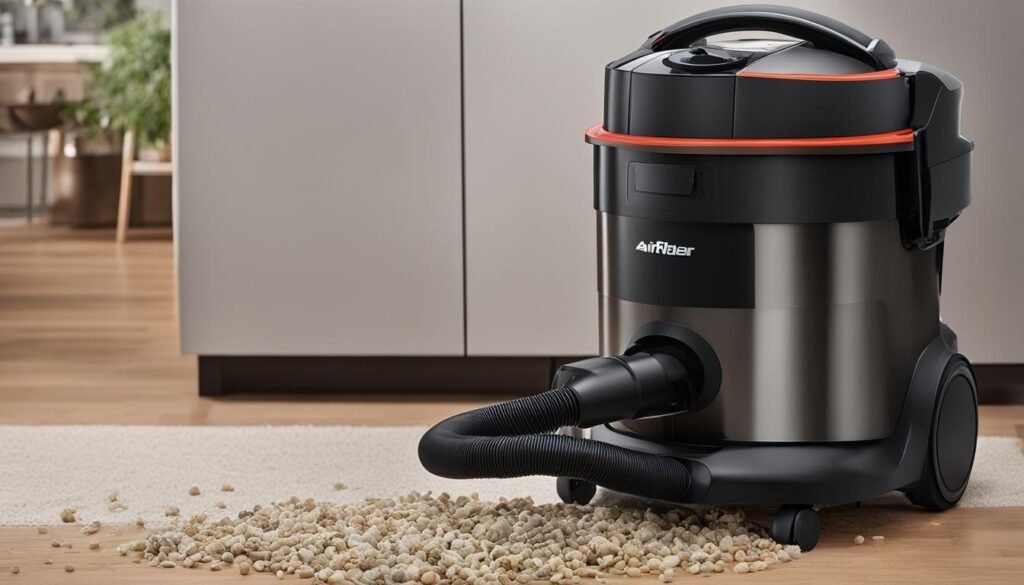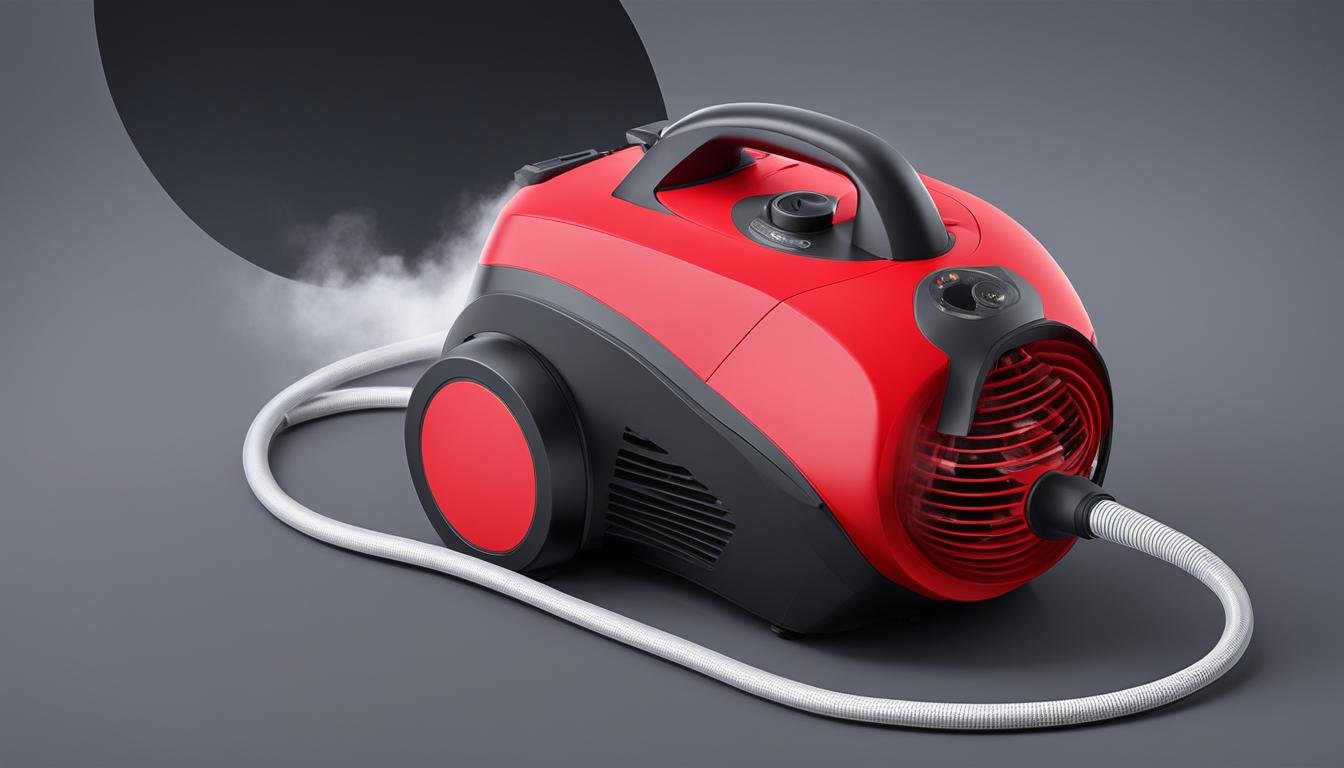When comparing vacuum cleaners, there are three primary specifications to consider. The first is motor input power, which is typically measured in watts. It’s important to ensure that the machines being compared have motor input power specified in the same unit for an accurate comparison. If one vacuum is rated in amps and the other in watts, a conversion can be done to make a direct comparison, but it’s important to only consider the motor amps for this conversion.
Key Takeaways:
- Vacuum cleaner performance can be measured by considering its CFM (cubic feet per minute) rating.
- CFM indicates the machine’s ability to move air, resulting in better dirt pickup.
- When comparing vacuum cleaners, ensure that the motor input power is specified using the same unit.
- Higher CFM ratings indicate greater airflow for optimal cleaning performance.
- Consider a vacuum cleaner with a CFM rating of 100 or above for canister vacuums and 60 or better for upright vacuums.
The Importance of CFM in Vacuum Cleaners
When it comes to optimizing the performance of your vacuum cleaner, understanding CFM, or cubic feet per minute, is crucial. CFM is a measurement of airflow, and the CFM rating of a vacuum cleaner directly impacts its cleaning ability.
The higher the CFM, the more air the vacuum cleaner can move. This means that a vacuum with a higher CFM rating can pick up more dirt and debris from surfaces, resulting in a more effective cleaning experience.
To put it simply, CFM is a key factor in determining how well your vacuum cleaner can tackle everyday messes. It’s not just about suction power; CFM plays a significant role in optimizing the overall cleaning performance of your vacuum cleaner.
Optimizing Vacuum Cleaner CFM
If you want to ensure that your vacuum cleaner delivers top-notch cleaning results, here are a few tips to optimize its CFM:
- Regularly clean or replace filters: Clogged or dirty filters can restrict airflow and reduce CFM. Keep your vacuum cleaner operating at its best by regularly cleaning or replacing the filters according to the manufacturer’s recommendations.
- Unclog hoses and attachments: Check for any blockages or debris in the hoses and attachments. Clearing these obstructions allows for better airflow and improved CFM.
- Check for leaks: Ensure that there are no leaks in the vacuum cleaner’s system. Any air leaks can significantly impact CFM and diminish the overall cleaning performance.
- Keep the brush roll clean: The brush roll can accumulate hair, threads, and other debris, obstructing airflow. Regularly remove any build-up to maintain optimal CFM.
By following these tips, you can enhance the CFM of your vacuum cleaner and maximize its cleaning efficiency.
“A higher CFM rating means more airflow, resulting in a vacuum cleaner that can pick up dirt and debris more effectively.”
Increasing CFM in Vacuum Cleaners
If you’re looking to increase the CFM of your vacuum cleaner, there are a few options to consider:
- Choose a vacuum cleaner with a higher CFM rating: When purchasing a new vacuum cleaner, prioritize models with higher CFM ratings for improved cleaning performance.
- Upgrade the motor: Some vacuum cleaners allow you to upgrade the motor, which can lead to an increase in CFM. Consult the manufacturer’s instructions or contact their customer support for guidance on motor upgrades.
- Optimize the airflow path: Ensure that the airflow path in your vacuum cleaner is free from obstructions. Clean any dust or debris that may accumulate in the motor housing or air ducts.
By taking these steps, you can make significant improvements to the CFM of your vacuum cleaner, resulting in a more efficient and powerful cleaning experience.
https://www.youtube.com/watch?v=EhcF0MH9HfQ
Understanding CFM Ratings and Suction Power
When it comes to vacuum cleaners, two important specifications to consider are CFM ratings and suction power. While these terms may sound similar, they actually measure different aspects of a vacuum’s performance.
CFM, or cubic feet per minute, is a measurement of airflow. It indicates how much air the vacuum cleaner can move in a minute. The higher the CFM rating, the more effectively the vacuum can pick up dirt, dust, and debris from surfaces.
On the other hand, suction power refers to the air pressure differential that creates force. It determines the vacuum’s ability to lift and remove dirt from various surfaces.
It’s important to note that while high suction power is desirable, it doesn’t guarantee efficient cleaning if the vacuum has a low CFM rating. You may have a vacuum with excellent suction power, but without sufficient CFM, it may struggle to pick up dirt and debris effectively.
“CFM measures the volume of air moved, while suction power determines the force created.”
So, why is understanding CFM ratings and suction power important? Well, when deciding on a vacuum cleaner, it’s essential to strike the right balance between CFM and suction power. A vacuum with high CFM and appropriate suction power will provide optimal cleaning performance and efficient dirt pickup capabilities.
Key Takeaways:
- CFM measures the volume of air moved by the vacuum cleaner, while suction power refers to the air pressure differential that creates force.
- High suction power alone doesn’t guarantee efficient cleaning; it’s essential to have a vacuum with an adequate CFM rating.
- Choosing a vacuum cleaner with the right balance between CFM and suction power ensures optimal cleaning performance.
Now that we understand the importance of CFM ratings and suction power, we can make informed decisions about selecting the right vacuum cleaner for our cleaning needs.

Conclusion
In conclusion, the CFM rating is a crucial factor to consider when evaluating vacuum cleaners. The CFM measurement directly affects the machine’s cleaning performance by indicating the airflow and dirt pickup capability. A higher CFM rating signifies greater airflow, resulting in more effective dirt removal.
To ensure optimal cleaning performance, it is recommended to choose a vacuum cleaner with a CFM rating of 100 or more for canister vacuums and at least 60 for upright vacuums. These ratings indicate efficient airflow and effective suction power, ensuring thorough cleaning on various surfaces.
When comparing vacuum cleaners, don’t overlook the importance of the CFM measurement as it directly impacts their cleaning abilities. By selecting a vacuum cleaner with a higher CFM rating, you can enhance its overall performance and achieve cleaner and healthier surroundings.
FAQ
How many CFM is a vacuum cleaner?
The CFM rating of a vacuum cleaner varies depending on the model and brand. It typically ranges from 40 CFM to 150 CFM or more. Higher CFM ratings indicate greater airflow and better dirt pickup.
What is the importance of CFM in vacuum cleaners?
CFM is crucial in determining the cleaning ability of a vacuum cleaner. Higher CFM ratings mean the machine can move more air, enabling it to pick up more dirt and debris from surfaces. Optimal cleaning performance is achieved with a CFM rating of 100 or more for canister vacuums and 60 or better for upright vacuums.
How does CFM relate to suction power in vacuum cleaners?
CFM and suction power are not the same. CFM measures the volume of air moved by the vacuum cleaner, while suction power refers to the air pressure differential that creates force. A vacuum cleaner can have great suction power but struggle to pick up dirt and debris if it has low CFM.





Leave a Reply